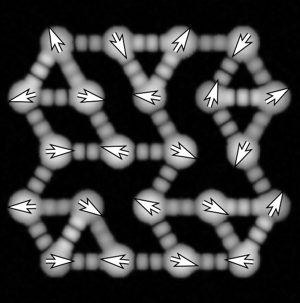The ‘spin glass problem’ is a complex situation in which the preferred directions of magnets seem to be fully random, as if they’re frozen. This problem is also a model for large-scale mathematical problems in, for example, artificial intelligence, logistics or DNA-sequencing. Complex problems ask for unconventional solutions, according to Jan Klärs of the University of Twente. Using lasers and photonics, he wants to simulate the spin glass problem. For this, the European Research Council awarded him a Consolidator Grant.
We usually associate magnets with two preferred directions or ‘spins’, not with a random situation. Still, for a certain temperature, this situation may happen. It is a bit like glass that is disordered and hasn’t got a nice crystal structure – hence the name of the spin glass effect. It is known for being a model for very complex mathematics, that isn’t easy to solve using current computer technology.
Optical computer
 This is why Jan Klärs proposes to simulate the problem using a 'dedicated' optical computer, consisting of lasers and photonic components. Multiple laser sources transmit their laser light to so-called resonators manipulating the light of certain colors and directions. In this way, he expects to demonstrate ‘proof of principle’ of a method that solves the problem much faster.
This is why Jan Klärs proposes to simulate the problem using a 'dedicated' optical computer, consisting of lasers and photonic components. Multiple laser sources transmit their laser light to so-called resonators manipulating the light of certain colors and directions. In this way, he expects to demonstrate ‘proof of principle’ of a method that solves the problem much faster.
For this ambitious plan entitled Networks of coupled photon Bose-Einstein condensates: when condensation becomes a computation, the European Research Council awarded him a ‘Consolidator Grant’, worth 2 million euro for a period of five years.
In this round, the European Research Council awarded a total of 655 million euro to European researchers.
Jan Klärs is an assistant professor of Nanophotonics, in the Complex Photonics Group that is part of UT’s MESA+ Institute.





